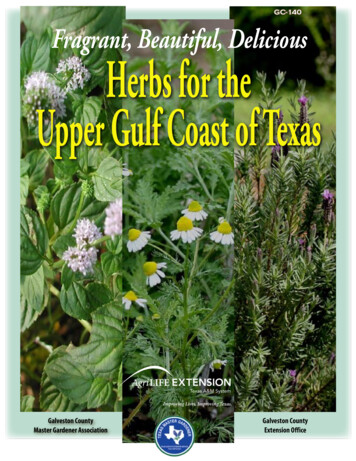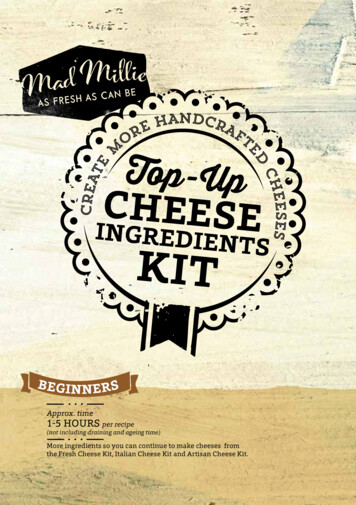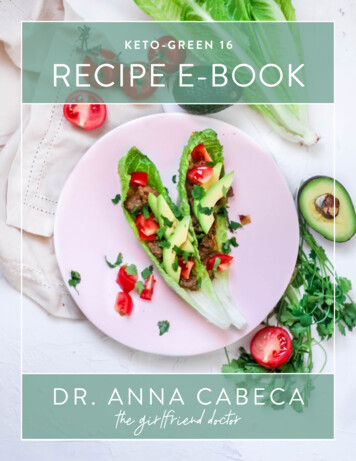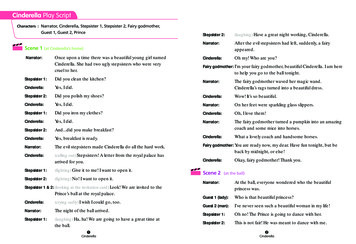
Transcription
GC-140Fragrant, Beautiful, DeliciousGalveston CountyMaster Gardener AssociationGalveston CountyExtension Office
byAlcestis “Cooky” Oberg (MG 2002)Anna Wygrys (MG 1992)Sandra Devall (MG 1998)Linda Steber (MG 1991)Candice Hawkinson (MG 2006)Gayle McAdoo (MG 2005)Donna Ward (MG 1996)Herman Auer (MG 1983)Deborah Repasz (MG 2003)
Gracious thanks for their invaluable assistance:Madalene Hill, world authority on herbsGwen Barclay, executive chef for Festival Hill InstituteJim Johnson, Director, Benz Schoolof Floral Design, Texas A&M University
Table of ContentsIntroduction . . . . . . . . . . . . . . . . . . . . . . . . . . . . . . . . . 5CHAPTER 1The Fountainhead: Madalene Hill . . . . . . . . . . . . . . . . . 9CHAPTER 2Top Twelve Herbs for Galveston County . . . . . . . . . . . 17CHAPTER 3Nice-to-Have Herbs . . . . . . . . . . . . . . . . . . . . . . . . . . . 25CHAPTER 4Onions, Garlic, and Salad Herbs . . . . . . . . . . . . . . . . . 33CHAPTER 5Herbs in the Garden and Landscape. . . . . . . . . . . . . . . 41CHAPTER 6Herb Culture – How to Grow Healthy Herbs . . . . . . . 47CHAPTER 7The Culinary Use of Herbs. . . . . . . . . . . . . . . . . . . . . . 57CHAPTER 8Floral Design with Herbs . . . . . . . . . . . . . . . . . . . . . . 71CHAPTER 9Use of Herb Scents. . . . . . . . . . . . . . . . . . . . . . . . . . . . 77CHAPTER 10Great Regional Herb Gardens to Visit . . . . . . . . . . . . . 87Bibliography . . . . . . . . . . . . . . . . . . . . . . . . . . . . . . . . 91
All rights reserved. No part of this work covered by the copyright hereon may be reproduced orused in any form or by any means without written permission from theGalveston County Master Gardeners Association.Photos are property of the Galveston County Master Gardener Association Photo Library takenby Galveston County Master Gardeners.
IntroductionHuman fascination with herbs started thousands of years ago. They haveplayed an important role in medicine, politics, religion, romance, cooking, perfume-making, and superstition throughout human history.It is believed that Neolithic man used herbs for food, healing, and shamanicrituals. For instance, marjoram pollen was discovered in caves dating back 60,000years. Some herbs were believed to have magical powers, and were sometimesburned for their pleasing scent to keep the gods appeased. Many herbs had medicinal uses, and have been used for millennia to cure illnesses. Today, herbal folkremedies are used by most of the world’s population, especially in countries whererefined pharmaceuticals and advanced medicine are not available or affordable.Written references about herbs were found as far back as 3000 B.C. The Chinese considered artemisia (an early species of sagebrush) to have special properties. The seminal ancient Greek physician Hippocrates lauded the use of mustardand other herbs in his cures. For thousands of years, herbs were relied upon by allcultures to preserve the taste of meats before refrigeration and to flavor dishes thatwould otherwise be boring and bland. Herbs and herb fragrances have factoredinto the creation and use of cosmetics too. Even today, herbal shampoos, sprays,perfumes, and lotions abound in all our stores. During Victorian times, a “tussie-mussie,” a small bouquet of flowers and herbs, was given as a message of loveor displeasure to someone, like a letter or a poem. Herbs have been used in floraldesigns too, as background greenery to freshen and enliven an otherwise staidfloral bouquet.
What’s an Herband What’s a Spice?The word “herb” comes from the Latin word ‘herba’ meaning “grass.” The “h” was not pronounced in Latin or in theearly romance languages. However, Old and Middle Englishdid generally pronounce the “h”, as British English still doestoday. In American English, the “h” can be pronounced or canbe silent as other romance-language borrowed silent “h” wordslike “honor”, “hour”, and “honest”.An herb is defined as “a flowering plant whose stem aboveground does not become woody and is valued for its medicinal properties, flavor, and scent.” A spice is defined as “aclass of pungent or aromatic substances of vegetable origin,used as seasonings and preservatives.” An herb is generally aplant whose leaves and stems are used such as mint, basil, dill,parsley, and bay. Spices include dried seeds (cumin, cardamom, mustard), buds (cloves), fruit or flower parts (pepper,saffron) and bark and roots (cinnamon, ginger). To add to theconfusion, some plants are both herbs and spices. For instance,allspice is a plant whose leaves can be used as an herb, like bayleaf, while its dried seeds are used as a spice.Herbs in AmericaNative Americans utilized almost every wild, nonpoisonousplant, including herbs, from the tanning and dyeing of leatherto the preservation and flavoring of their foods. Early European settlers brought their native herbs and foods when theytraveled to the New World. This resulted in an exchange ofslips, seeds, and plants. The pioneers used herbs, not only forillnesses and food flavoring, but also as a potpourri to protectlinens from insects, or to improve the smell of their householdsscattered on floors or burned like incense. Because there wasno easy access to water, colonialists used herbs as perfumes anddeodorants too. Other herbs were used to dye homespun fabrics. Settlers often found varieties of herbs they were familiarwith - anise, parsley, lavender, liverwort, pennyroyal, sorrel,watercress, and leeks — which grew wild in the New World.In 1776, the Shakers started the first true herb farms inAmerica, quite similar to herb farms we have today. Throughout the 18th and 19th centuries, the Shakers made a business ofbaling and selling herbs to pharmacies throughout the easternUnited States, and became a major focal point of herb cultivation in America.
Madalene Hilland the Rebirth of Herb CuisineMadalene Hill, a quiet little Texas woman, revolutionizedthe use of herbs when she established Hilltop Herb Farm inthe early 1960s, and featured the use of fresh herbs in herrestaurant cuisine. Madalene Hill was a relentless explorer, soas she traveled, she collected herbs throughout the world andintroduced them into our cuisine, our gardens and our lives.Also, as more ethnic cuisines became prominent in Americancooking from the 1960s onward – Italian, French, Chinese,Greek, Thai, Indian, Polynesian, Vietnamese, Latin American, African, and so on — so also the American public wasintroduced to hundreds of new herbs and spices, and theirculinary and aromatic uses.In Galveston County, the Madalene Hill legacy lives on inthe growing interest of establishing herb gardens in our backyards, and using them in our kitchens and homes to brightenand enhance our enjoyment of life.Our BookWe start our herb book with a brief biography of MadaleneHill, the fountainhead of our herb knowledge and herbappreciation today. This little Texas lady spent many yearsof her life in the Houston/Galveston area, and did moreto broaden our knowledge and use of herbs than any otherAmerican. Our subsequent chapters focus on the herbs thatgrow best in Zone 9 of the Upper Gulf Coast of Texas, sincesome herbs don’t enjoy our heat, our alkaline soil, our rainfall, and our humidity. It’s important to know how to growherbs and use them in our landscape, so we have devotedwhole chapters to those subjects, along with chapters onhow to use herbs to flavor our foods, to brighten our floraldesigns, and to freshen the fragrance of our homes. Last butnot least, we invite our residents to immerse themselves inthe world of herbs by visiting the great herb gardens in ourregion.Throughout the book, we have focused on the importantpeople who have shared their knowledge and experienceof herbs with us. Their knowledge is real, hands-on — notabstract and removed. The personalities of Madalene Hill,Gwen Barclay, Donna Ward, Jim Johnson, and others willshine through these pages, as they give their personalizedinsight into and their experienced advice on the confusingworld of herbs.We hope our herb book brings our readers as much pleasure, knowledge, and joy in herbs as it has brought us, theGalveston County Master Gardeners.
10
CHAPTER 1The Fountainhead:Madalene HillA life among these “little plants”Her status in the world of herbs is legendary. Her knowledge of herbs is encyclopedic. She is regarded the fountainheadof what we know about herbs today, and has garnered every honor there is in her field. There are gardens named afterher, to honor her titanic contribution.Yet, slender modest Madalene Hill doesn’t mention anything about her honors. Always with a bright light in her eyesand a gentle smile on her face, she is eager to listen to people’s experiences with herbs – how they grow them, whatthey do with them. Her residence, the historic 1902 Menke House at the International Festival Institute at Round Top,Texas, is surrounded by the enormous McAshan Gardens, dedicated to herbs from the entire planet. And Madaleneknows every herb like a friend. She planted them all.11
During a tour of the gardens, Madalene points out some of the morerare and wonderful herbs in the sun-dappled Sun-Shade Garden besideMenke House – a fascinating coriander here, an amazing salvia there – asbutterflies dance in the light. Beyond that is an astounding collection ofthe medicinal herbs of the world in the sunny Pharmacy Garden, laidout by continent. “We don’t have many from Australia yet,” she sighed.“Most of their medicinal herbs are trees, hard to transport.”Marian gardenOn the other side of Menke house lies a charming garden framedby classical columns, devoted to plants named for the Virgin Mary.The Mediterranean Garden holds rosemaries, sages, and oreganos thatthe ancient Greeks and Romans may have cooked with. There are approximately 2500 genera of herbs growing in the gardens surroundingMadalene Hill today, including over 200 salvias, over 100 rosemaries,and 25 kinds of oregano. On a stroll through this incredible gatheringof the world’s herbs, it’s impossible not to learn something miraculousabout them, and hear wonderful stories about the adventures of collecting them. Madalene always encourages people to pinch off a little pieceof an herb and enjoy its unique fragrance, then compare it to anotherone growing a few feet away.BeginningsRock Island signRock Island General Store ruinHer remarkable life among ”these little plants” started November 7,1913 in Rock Island, Texas. Rock Island was located south of Columbus, Texas, with population of about 400 at that time. It was a smallRock Island railroad town, hence the name. This was a rice-growing areasettled by immigrants primarily from Denmark who came there at thebeginning of the 20th century. Madalene’s father, like most residents ofRock Island, was a rice farmer, who worked hard to make the tough landproductive. Madalene’s maternal grandparents, her mother and an auntare buried in the cemetery there.When Madalene was three years old, her mother left Rock Islandwith her two children (Madalene and her younger brother) and movedin with an older sister in Elbing, Kansas, where the family ran a boarding house to accommodate the men working during the oil boom afterWorld War I ended. Elbing was a tiny town located along the railroadline between between Wichita and Peabody, Kansas, and the town hadreached a population for just over 100 when Madalene arrived there.It was a tight-knit community of Germans, and Madalene could speakhigh and low German. Some Russians also settled there, and brought thered winter wheat variety into the region, which still thrives there. Elbingis still a small hamlet now, but the Mennonites established a church anda school that are still there.Elbing didn’t get electricity until 1929 and the residents had to provide their own water from cisterns. Madalene remembers the woodensidewalks along the main street and the way the men shaved their heads– the prevalent male haircut of the day.Her mother and aunt did all the cooking at the boarding house.Madalene’s first memory of herbs was the sage tea, brewed in the fall andwinter to “ward off the biliousness caused by the autumn and winter12
foods, such as sausage, beans, and cabbage.” Her mother remarried in1919, and moved to a different house nearby. The aunt became a cookfor a college professor’s family. But Madalene clearly remembers how themore Germanic herbs, like dill and caraway, were used in pickling andcooking seasonal foods. “We pickled everything,” she recalls, because winters were severe and long, and fresh produce in most months was scarce.Peppermint was used in teas too.Madalene, the oldest of 13 children, had to leave high school in 1929to help support the family. She worked as a secretary and bookkeeper.Eventually, she went to work for the Federal Land Bank in Wichita,key-punching on IBM machines. “The desks were on two sides, just likeyou see in old movies,” she recalls. “We had to work on Christmas Evenight 1930, processing loans for desperate farmers.” Wichita and the surrounding areas were made up of Mennonites, Dutch, Quakers, Amish – adiverse assortment of traditional farming people. She remembered thatloans for everyone but the Mennonites, Quakers, and Amish requiredsome kind of background check: “But with them, their word was theirbond. Every bank knew it.”age for sage teaReturn to TexasShe married her first husband in 1933, and her son was born in 1934.They moved to Houston, Texas, in 1935, and Gwen, her daughter andnow fellow herb expert, was born in 1937. Madalene worked for theFederal Land Bank in Houston, and then at IBM. When Madalene’smarriage ended, she became the sole bread-winner, and single motherof two children, living in the 1900 block of Travis. She found a sweetfarm girl from Wisconsin as a sitter, whose family was French. When thesitter moved back to Wisconsin, she found a wonderful African-American woman. Both were good cooks and a great help in raising her twoyoungsters. At home, Madalene always had sage growing in pots, alongwith a few onions.From World War II to her retirement in 1957, she rolled up manyfirsts: the second female shipyard manager (1941), and the first femaleoffice manager at IBM (1949 to 1951), a company renowned for nothaving many women employees). Inside this little, modest, unassumingwoman beat the heart of a revolutionary and a trail-blazer.She married her second husband, Jim Hill in 1951. As soon as shemarried, she lost all her IBM benefits, which was company policy at thetime. He was 25 years older than she was, and an avid gardener. Jim wasborn in Texas, and had four sisters who taught him cooking and gardening — how to plant pansies and cabbages together, for instance, an oldorganic companion-planting method still used today. In World War I,he had been stationed in France, cooking and procuring food. He stayedthere for two years after the war with a small group of officers chargedwith winding up aid to the French in their area. He learned about European vegetables, flowers, and cultivation methods. When he came back,he worked as an engineer for a company that specialized in small instruments. When the firm announced that it would have to lay off someworkers in 1957, Jim Hill took early retirement, so one of the youngermen who worked for him could keep his job.13Methodist Church at Rock Island
Hilltop FarmMadalene left IBM in 1957 also, and the Hills moved to a 12½ acrefarm they got at a bargain price near Cleveland, Texas. Jim wanted to growgladiolas on a commercial scale for florists. By this time, Madalene’s son wasmarried, and Gwen was in college. It took two years to get the land readyfor the 200,000 gladiolus corms Jim was going to plant.A Texas A&M professor was intrigued by the Hills, and wanted to workwith them on soil preparation, terracing, and so on. They brought in humusfrom the neighboring logging operations that had mounds of wood chips.They planted a green cover crop to preserve their soil, and then plowed itunder and planted the Dutch gladiolas in 1959.They hired three African-American workers, who worked only during thedaytime, fearing for their lives if they were caught in a technically “white”area at night. Every 10 days, starting December 10, they planted the corms:one made the hole, one placed the corm in the hole, one covered the hole.Madalene recalls that they planted the bulbs deeper than recommended,and pulled soil up around them as they grew, so they wouldn’t have to stakethem. Their irrigation system was considered revolutionary for this crop:they watered every week, at least one inch. The first cuttings occurred intime for Mother’s Day when the prices for flowers were always good. Theyhad to cut the flowers at first light, and have the harvest ready for pickupno later than 3 am, so the wholesale Houston florists would have them inhand. As soon as they got to the farm though, they grew vegetables andherbs, starting in a tiny greenhouse. “The neighbors heard the Hills prepared squash with fresh herbs, and put sage, marjoram, and oregano in theirgravies, and sometimes herbs in the cornbread too,” Madalene recalls.14
But herbs were hard to find. “There were only three sources for herbs inthe U.S. at that time, all on the East Coast,” Madalene remembers. “They’dship in May or June, and it took 10 to 15 days to get them. Frequently,we had to reorder. That’s not the optimum time to grow herbs in Texas.”She joined the Herb Society of America in 1957, and started to get seedsfrom the Society’s gardeners. Even then, there were only a dozen or so herbscirculating, mostly grown as garden plants not culinary components.By the 1950s, oregano and chives were getting more popular because ofthe prevalence of Italian food in many cities. Basil was not yet popular.The gladiolas did well for three years, but A&M thought it might be abetter crop for the Valley. The Hills briefly raised chickens to sell eggs, butlost money on that and got out. The chicken droppings, however, madegreat fertilizer.They started to grow herbs and sell them retail and mail order at theirfarm, by then named Hilltop Herb Farm. People would sometimes cometo the farm to buy herbs, and then stay until they got hungry. Madalenewould serve them an herb-flavored lunch in the greenhouse, a revolutionarycuisine at that time. “It started out in 1961 with three tables — old ladiesin tennis shoes,” she recalls. “Then people started calling for reservationsand we expanded it — borrowed chairs from the funeral home, because wethought it wouldn’t last.” They were open only once a week — Wednesday.People kept coming for the flavors of the food that were, as one AfricanAmerican worker called it, “very subtle — pronounced sub-tell”. The Hills’natural frugality (“You can call us tightwads,” she sniffs) led them to doingeverything they could with their abundant crops of herbs: dry them, package them well, make jellies and teas out of them, mix them with local fruit.15
After an article in the Houston Chronicle about the restaurant in 1961,there were hundreds of calls asking for herbs, and many curious people whotold Madalene, “Mom had some stuff in her dumplings, and something elsein her stew. What was that?” Business boomed. The “little plants” — andthe responsive chord they touched in people – had changed the Hill’s livesforever. Before long, eager customers from all over the nation, from as faraway as New York and California, came to eat at Hilltop Herb Farm. Busespulled up with tourists eager to dine at America’s most unique restaurant.“Everyone got a finger-bowl with a rose geranium or some lemon verbenaat the end of the meal to rinse off their fingers,” Madalene chortles. “Butsome drank it!”Madalene adored lecturing, writing, and teaching too, which she beganin 1961. During the 1960s, the farm expanded to serving six meals a weekin the large Garden Room. By 1967, menus became more cosmopolitantoo, and included foods of the world, using fresh herbs and exotic seasonings from afar.Madalene was a restless explorer too, traveling all over the world duringher vacations, learning the varieties and use of herbs from people everywhere: “I wanted to introduce people to good food, and the only way youcan do that is to talk to people, see how they gather and prepare their food.”She made it a badge of honor to never repeat a menu at Hilltop HerbFarm, except once: “A surgeon who worked in Houston wanted to bringsix French students there. He wanted duck — the whole meal — exactlyas we had prepared it when he had come to the restaurant.” Throughoutthe 1960s and 1970s, Madalene served both the average folks and famousones, such as astronauts, politicians, renowned doctors, and so on. She alsokept writing columns and articles, gave more talks about growing and usingherbs, and single-handedly popularized herbs. The range of available herbson the market expanded from a dozen to many hundred in those years, aspublic interest grew. By the 1980s, people were experimenting with notonly all the different basils, but corianders, lavenders, mints of all kinds.DisasterIn the early 1980s, disaster struck. In 1982, Jim Hill died. In 1983, a terrible tornado struck and destroyed Hilltop Herb Farm. Though nobody waskilled, the farm was destroyed. Not only the buildings and trees were blowndown, but almost all the plants and 18-inches of topsoil were torn away.“Only five poppies were left, coming up from the ground,” she sighs. “Allthe herbs I had collected in eastern Europe were gone, seeds that had beenshared with me were gone, all the exotic things like cinnamon trees andclove trees were gone. It’s as if the soul had been ripped out of the place.”Though Madalene and her daughter Gwen rebuilt Hilltop Herb Farmand briefly even had a restaurant in Houston too, they sold the farm andgot out of the restaurant business in 1987.Madalene’s Sun and Shade Garden beside Menke16
After Hilltop Herb FarmAfter that, they traveled and lectured as a team. Madalene served as President of the Herb Society of American from 1986 to 1988, and pursued avery active writing career from 1960 to 2005, authoring and co-authoringhundreds of article. Together Madalene and Gwen wrote Southern HerbGrowing in 1987, the ultimate book on growing and using herbs, includingsome sensational recipes from their Hilltop Herb Farm kitchen.When Madalene became the Curator of the Susan McAshan Gardensat International Festival Institute at Round Top, Texas, she and Gwenmoved there in 1993. “There were no gardens when we came to FestivalHill – only some shrubs and trees that had been planted across the road byfamous horticulturalist Lynn Lowerey,” says Madalene. “We brought severalhundred containers of herbs and plants that I could not live without whenwe sold the farm. I put in all the gardens as an unpaid volunteer which Istill am. Gwen took the position of Director of Food Services as a paid staffmember. This was my choice. I named the gardens for Susan McAshan whowas a longtime friend. She had been a major benefactor for the beautifulstone work at Festival Hill as well as the concert hall. We called the Cloister Gardens and wall plantings ‘the McAshan gardens.’ I was dubbed the‘Curator’ of the gardens when I began putting in all the plants.” Madalenebegan the loving job of collecting, expanding, nurturing, and importing toultimately create one of the finest herb gardens.Madalene really relished the years she traveled all over the world, gathering herbs and bringing them home. “Things just leap into my pockets,” shelaughs. She brought back cutting and seeds from South America, EasternEurope, everywhere she went. One time, she and Jim wound up in Bulgaria: “There were 50 miles of roses on one side of the road and 50 milesof lavender on the other. It was an amazing sight. They distilled them touse in perfumes, soaps, cleaning agents. But they were secretive about thedistillery, finally agreeing to let them see it.”Over the years, she’s developed a creed in using herbs in food: No oneherb should come out and bang you over the head. “The foods we cookedat Hilltop,” she says, “were a wonderful blend of flavors. No one thingdominated.” The subtle herbs blended with the other ingredients to createa synergy, where the final flavor of the dish was greater than the total of itsingredients. Gwen refined this practice to a high degree at Festival Hill.A Life Among These Little PlantsThough she never went to college, Madalene has the equivalent knowledge of several PhDs in horticulture and botany, and can rattle off theLatin names of rare herbs as if they were relatives. She’s had gardens namedafter her, and a long list of medals and awards for excellence and lifetimeachievement. But her greatest honor, she says, is: “To have been the facilitator for the introduction of culinary herbs and herbs for the landscape toso many through the years. These small fragrant plant have changed thelives of many.” The herbs she personally introduced to the marketplace arewonderful: Mexican Mint Marigold, Hilltop Oregano, “Madalene Hill”Doublemint and Arp Rosemary, Ball Basil, “Newe Ya’ar Salvia”, and others.17Southern Herb Growing book cover
“I loved all the years of sharing knowledge of these little plants withpeople I would have never met or known otherwise,” Madalene says. “It wasknowledge of a practical kind, not always in books and not always done bycollege graduates. I learned so much from ordinary people whose knowledgeof an herb — how to cultivate it, propagate it, use it – was really profound.People have told me that when they’re troubled, they walk among the herbsand their thoughts change, the minds and bodies heal. Herbs have beenspeaking to people in all places, in all cultures, and across all times. Theyevoke memories of food, home, ancestry.”Madalene’s “Life among these little plants.”When she autographs books, she always inscribes a friendly favorite saying: “Grow Where You Are Planted.” It’s not only a friendly greeting for herfans, but a philosophy and a way of life. Wherever she was planted in herlong life, she grew. Most significant, perhaps, is that she gave “these littleplants” a voice, a place to thrive and be known in gardens, kitchens andhearts across the world.18
CHAPTER 2TwelveMust-have Herb VarietiesKitchen gardens have always provided not only the family’s fruits and vegetables, they also grew the flavorings, preservatives,and medicines needed to survive. Every cook worth a pinch of salt values these twelve culinary herbs. For the most flavorfulherbs, freshness is paramount; and home-grown herbs are the freshest.As a point of interest, the Latin botanical name “officinalis” designates varieties that have medicinal uses. Because herbs canbe of varying strengths, self-medicating can be risky.19
Basil Ocimum basilicumBasils are tender annuals that grow best in full sun. Plant seeds in aslightly acid (5.5 to 6.5 pH) loose, moderately fertile soil in the spring).Seedlings are very susceptible to “damping-off ” if too moist. The maturesizes range from a compact eight inches to over three feet. Harvesting keepsplants compact, bushy and removes blooms that shorten the plant’s life.VARIETIESThere are over 200 recognized varieties, and some are very ornamental.‘Anise’ basil smells like licorice and is a favorite of Asian cuisines.‘Black or Purple Opal,’ a basil with distinctive deep purple, ruffled leaveswas hybridized in 1962 at the University of Connecticut and a winnerof the All-America medal. Prized for the unusual foliage and bi-tonedlavender and white flowers, it won as an ornamental.‘Cinnamon’ basil has purplish, green foliage and pink flowers. It has a distinctive spicy fragrance.Greek basil, O.b. ‘Minimum’ has a medium flavor and is tolerant of poorsoil conditions.Lemon basil, O.b. ‘Citrodorum’ has a light lemon scent.‘Nufar Hybrid’ is resistant to a fungal disease called Fusarium Wilt.‘Sweet’ basil can refer to three different varieties. ‘Napolentano’ has large,light green leaves with a mild aroma and smooth, buttery flavor.‘Genova profumatissima’ has long, pointed, shiny foliage. ‘Fino verde compatto’ has clusters of tiny sweet leaves and matures at 12 inches.‘Spicy Globe’ basil is ideal for growing as a border or container plant. Itmatures at about 12 inches.Other AAS winners are O.b. ‘Thai Siam Queen’ in 1997, O.b. ’LemonSweet Dani’ in 1998 and O.b. ‘Magical Michael’ in 2002.Bay Laurel or Sweet Bay Laurus nobilisBay Laurel is an evergreen tree that can reach over 20 feet. It is hardyto 10 F and can be grown in average soil in full sun to partial shade locations. Protection from strong winds and temperatures below 40 F is advisedto prevent winter leaf damage. Even soil moisture and good drainage areabsolute requirements. Fertilizer should be applied twice annually, in earlyspring and late summer. Mature trees will bloom tiny yellow flowers in thespring. The fruit is a purple-black berry. Propagation is by cuttings that arevery difficult to root.VARIETIESL. nobilis Golden Bay ‘Aurea’ has golden foliage and is more hardy thatsweet bay.L . nobilis ‘Angustifolia’ or willow leaf bay has long, narrow leaves.20
Chives Allium tuberosumChinese chives have a distinct garlic flavor. The foliage is flat and strappy.Blooms are clusters of white flowers that develop small black seeds in pods.The origin of the onion chive is unknown. Allium schoenoprasum oronion chives are the smallest of the Allium family. The tubular foliage hasa light, delicate flavor. The small bulbs grow in clumps and prefer a slightlyacid soil with a pH between 6.0 and 7.0. A loose soil with good drainageis essential. Some shade during the hottest weather helps chives to survivethrough the summer. A light application of fertilizer after harvest will promote new growth from the center of the bulbs. Chives should be dividedevery three to four years to keep the clump vigorous. Propagation is bestdone in the fall.GarlicThe r
world of herbs. We hope our herb book brings our readers as much plea-sure, knowledge, and joy in herbs as it has brought us, the Galveston County Master Gardeners. 10. 11 CHAPTER 1 The Fountainh










